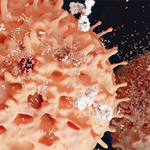“In conclusion, our results indicate that naïve activated autoreactive B lymphocytes that differentiate into antibody secreting cells are essential elements for serum anti-extractable nuclear antigen Ab production and, particularly, for ACPA production,” write the authors. “Whereas antibody secreting cells are cells capable of producing anti-extractable nuclear antigen Ab without stimulation, hence at an effector stage, autoreactive B lymphocytes would represent potential effector B cells able to differentiate into antibody secreting cells under conditions of a potent stimulation, even non-specific, if the autoAg is also available.”
Lara C. Pullen, PhD, is a medical writer based in the Chicago area.
ad goes here:advert-1
ADVERTISEMENT
SCROLL TO CONTINUE
Reference
- de la Varga-Martínez R, Rodríguez-Bayona B, Campos-Caro A, et al. Autoreactive B-lymphocytes in SLE and RA patients: Isolation and characterization using extractable nuclear and citrullinated antigens bound to immunobeads. Eur J Immunol. 2019 Mar 20. [Epub ahead of print]
